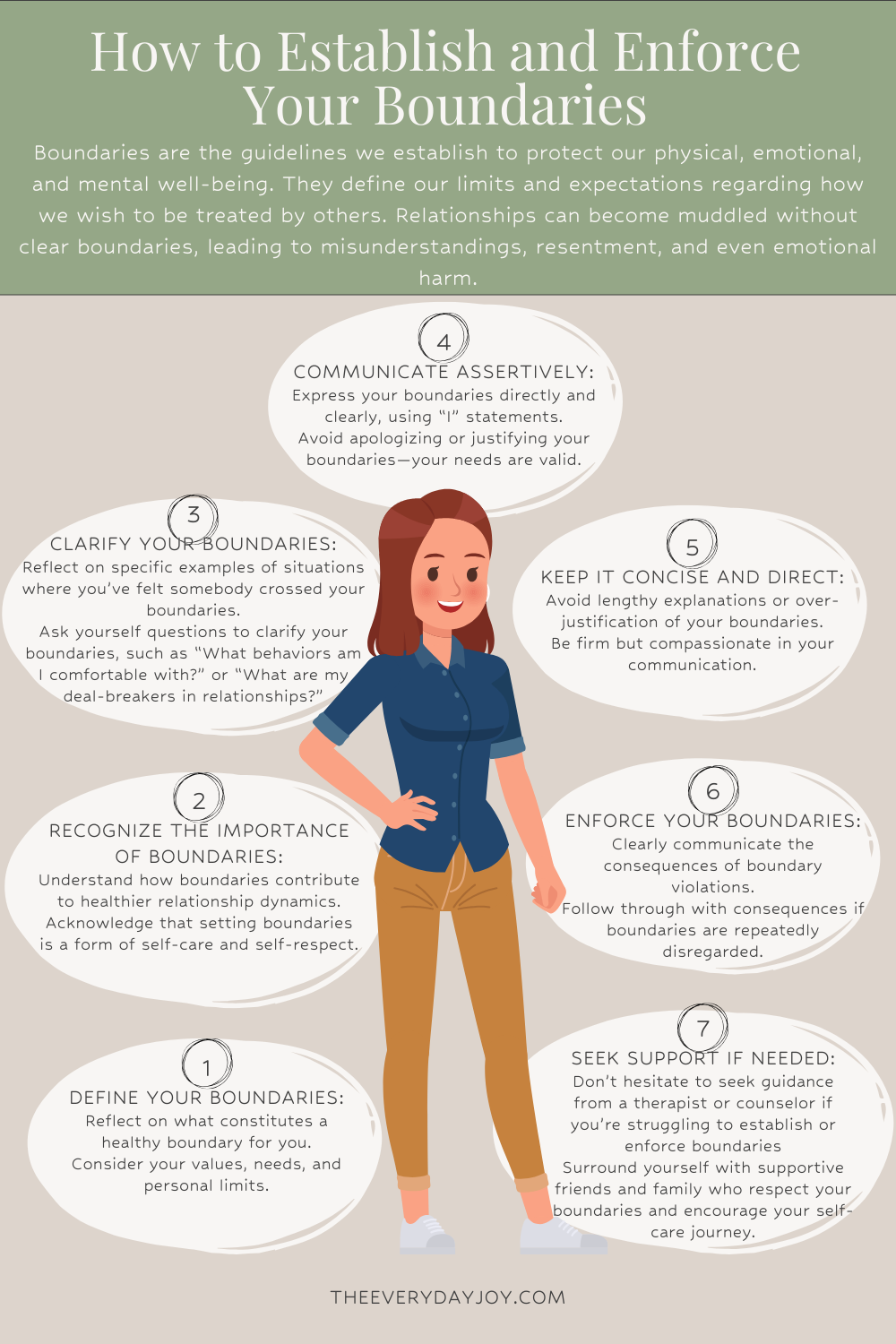Empower Your Relationships: Strengthening Connections with Boundaries

In the intricate dance of human interaction, boundaries are the invisible lines defining where we end and others begin. They are the framework within which healthy relationships flourish and thrive. In this blog post, we’ll dive into the essence of boundaries, why they’re crucial, examples of healthy boundaries in various relationships, and practical steps to establish and enforce them, all aimed at strengthening connections with boundaries.
What Are Boundaries?
Boundaries are the guidelines we establish to protect our physical, emotional, and mental well-being. They define our limits and expectations regarding how we wish to be treated by others. Think of them as the fences around our emotional and psychological space, designed to maintain a healthy balance between connection and autonomy.
Why Boundaries Are Important
Boundaries are the cornerstone of healthy relationships. They foster mutual respect, trust, and understanding. Relationships can become muddled without clear boundaries, leading to misunderstandings, resentment, and even emotional harm. By setting and maintaining boundaries, we honor ourselves and others, fostering deeper connections built on authenticity and empathy.
Examples of Healthy Boundaries in Relationships
With Family
- Setting aside designated “me time” to recharge.
- Communicating openly about personal needs and desires.
- Establishing limits on intrusive questioning or unsolicited advice.
Case Study – Establishing Family Boundaries
Sarah, who is in her early 20s, faced challenges in setting boundaries with her parents, who often intruded on her personal space and made decisions without consulting her.
Through meeting with her mentor, Sarah recognized the significance of asserting boundaries respectfully. Despite facing pushback initially, she expressed her need for autonomy and privacy to her parents. Sarah’s persistence and patience paid off, as her parents eventually began to understand and respect her boundaries, fostering a more harmonious relationship.
Sarah’s journey highlights the importance of assertiveness and persistence in setting boundaries with family members. Despite initial challenges, her commitment to her own well-being led to positive changes in her relationship dynamics.

With Friends
- Respecting each other’s privacy and confidentiality.
- Being honest about feelings and expectations within the friendship.
- Setting boundaries around borrowing personal belongings or time commitments.
Case Study – Friendship Boundaries: Establishing Respect and Equality
Michelle’s friendship with Lily faced challenges as Lily frequently crossed boundaries, borrowing money without repayment, showing up unannounced, and monopolizing their time together. Despite feeling uncomfortable with her friend’s behavior, Michelle hesitated to address these issues due to her fear of conflict. However, as Lily’s behavior persisted, Michelle realized the importance of setting boundaries.
With guidance from a mentor, Michelle learned assertiveness skills to address these concerns. She communicated her limits to Lily respectfully but firmly, explaining the impact of her actions and asserting the need for change. Surprisingly, Lily responded positively, expressing remorse and committing to respecting Michelle’s boundaries.
Michelle and Lily strengthened their friendship through open communication, establishing a more balanced dynamic based on mutual respect and understanding.
With In-laws
- Communicating openly and respectfully about personal boundaries.
- Establishing guidelines for visits and interactions.
- Asserting boundaries around parenting styles and decisions.
Case Study – Establishing Boundaries with In-Laws: Protecting Family Dynamics
Sarah and David faced strain due to David’s parents’ intrusive behavior. Sarah felt overwhelmed and frustrated, which impacted their marriage and parenting. David’s parents often disregarded boundaries by frequently dropping by unannounced, offering unsolicited parenting advice, and making decisions without consulting Sarah and David.
With mentoring, Sarah realized the need for clear boundaries to protect their family’s well-being. Initially hesitant, David supported Sarah’s concerns and acknowledged the strain caused by his parents’ actions. Together, they sought guidance on effective boundary-setting strategies.
In a series of honest conversations, Sarah and David established boundaries with David’s parents, emphasizing the importance of mutual respect and autonomy within their family unit. They communicated their need for advance notice for visits and boundaries around unsolicited advice. Despite initial resistance and pushback from David’s parents, Sarah and David remained firm in their boundaries, consistently reinforcing their expectations with patience and compassion. Over time, David’s parents began to understand and respect their boundaries, leading to improved communication and a more harmonious relationship.
With Significant Other
- Expressing preferences and needs within the relationship.
- Setting limits on disrespectful behavior or communication.
- Agreeing on boundaries regarding personal space and time apart.
Case Study – Establishing Emotional Boundaries in a Romantic Relationship
Mia and Jack had been together for several years, but their relationship was strained by Jack’s habit of making insensitive comments and disregarding Mia’s feelings. Mia, a sensitive individual, constantly felt disrespected and unappreciated, leading to a decline in her self-esteem and increased anxiety.
Realizing the detrimental effect of Jack’s behavior on her mental and emotional well-being, Mia sought support from a trusted friend and confidant. Through heartfelt conversations and guidance, Mia gained insight into the necessity of establishing boundaries in her relationship to safeguard her emotional health and cultivate a more respectful dynamic with Jack.
Equipped with newfound clarity and confidence, Mia initiated candid conversations with Jack, expressing her concerns and outlining her need for respectful communication and emotional support. Although initially resistant and defensive, Jack gradually understood the severity of Mia’s feelings and the need for change in their relationship dynamics. Through ongoing communication and effort, they collaboratively set clear boundaries that honored each other’s needs and emotions, fostering a deeper level of mutual respect and understanding.

With Coworkers
- Establishing boundaries around work-related tasks and responsibilities.
- Maintaining professionalism in communication and interactions.
- Setting limits on gossip or intrusive inquiries into personal life.
Case Study – Establishing Professional Boundaries with Coworkers
Katie found herself in a challenging workplace situation where a coworker constantly crossed professional boundaries. This coworker often interrupted Katie during meetings, shared confidential information without consent, and made inappropriate comments about her personal life. Although uncomfortable, Katie hesitated to address the issue, fearing conflict and potential repercussions.
With guidance from her supervisor and HR department, Katie learned how to communicate her boundaries with her coworkers assertively. She scheduled a private meeting and calmly expressed her concerns, outlining specific examples of the behavior that made her uncomfortable and explaining its impact on her work productivity and well-being.
Initially, Katie’s coworker seemed defensive and dismissive of her concerns. However, with consistent reinforcement of her boundaries and support from her supervisor, Katie’s coworker eventually recognized the importance of respecting professional boundaries. They began communicating more respectfully and collaborating effectively, leading to a more positive and productive work environment for both parties.
With Strangers
- Asserting personal space and physical boundaries.
- Politely declining unwanted advances or requests.
- Setting limits on how much personal information to share.
Case Study – Asserting Personal Boundaries with Strangers
Alexa found herself in a social gathering where a persistent stranger continuously invaded her personal space and ignored her subtle attempts to create distance. Despite Alexa’s discomfort, the stranger persisted in initiating unwanted physical contact and intrusive conversation topics.
Alexa confronted the situation directly, recognizing the need to assert her personal boundaries. With calm but firm communication, she expressed her discomfort with the stranger’s behavior and asserted her preference for engaging from a distance.
Initially surprised, the stranger apologized and respected Alexa’s boundaries, acknowledging the importance of consent and mutual respect. Empowered by this experience, Alexa now confidently asserts her boundaries in similar situations, fostering more comfortable and respectful interactions with strangers.
On Social Media
- Managing screen time by setting limits on daily usage
- Avoiding comparison traps by limiting content that may trigger feelings of inadequacy or envy.
- Establishing boundaries around engaging in debates
Case Study – Managing Social Media Boundaries
Amelia found herself engulfed in the endless scroll of social media, losing hours each day to mindless browsing. Recognizing the toll it took on her productivity and mental well-being, she decided to take control. Implementing strict time limits, Amelia restricted her daily social media usage to specific windows, allowing herself enough time for connection without sacrificing other aspects of her life.
However, Amelia also noticed how easily she fell into the comparison trap, feeling inadequate or envious when comparing her life to curated feeds. Determined to protect her self-esteem, she curated her social media content, unfollowing accounts that promoted unrealistic standards or triggered negative emotions. By surrounding herself with positive and uplifting content, Amelia fostered a healthier relationship with social media, free from comparison-induced stress.
Moreover, Amelia recognized the futility of engaging in endless online debates, often leading to frustration and conflict. Setting clear boundaries, she refrained from getting involved in contentious discussions, prioritizing meaningful interactions and positive engagement instead. By establishing these boundaries, Amelia reclaimed control over her social media experience, allowing it to enrich her life without overshadowing it.
How to Establish and Enforce Your Boundaries
Define your boundaries:
- Reflect on what constitutes a healthy boundary for you.
- Consider your values, needs, and personal limits.
Recognize the importance of boundaries:
- Understand how boundaries contribute to healthier relationship dynamics.
- Acknowledge that setting boundaries is a form of self-care and self-respect.
Clarify your boundaries:
- Reflect on specific examples of situations where you’ve felt somebody crossed your boundaries.
- Ask yourself questions to clarify your boundaries, such as “What behaviors am I comfortable with?” or “What are my deal-breakers in relationships?”
Communicate assertively:
- Express your boundaries directly and clearly, using “I” statements.
- Avoid apologizing or justifying your boundaries—your needs are valid.
Keep it concise and direct:
- Avoid lengthy explanations or over-justification of your boundaries.
- Be firm but compassionate in your communication.

Enforce your boundaries:
- Clearly communicate the consequences of boundary violations.
- Follow through with consequences if boundaries are repeatedly disregarded.
Seek support if needed:
- Don’t hesitate to seek guidance from a therapist or counselor if you’re struggling to establish or enforce boundaries
- Surround yourself with supportive friends and family who respect your boundaries and encourage your self-care journey.
Conclusion
Setting and enforcing boundaries is a skill that requires practice and self-awareness. By prioritizing your own well-being and communicating your needs effectively, you can cultivate relationships that are built on mutual respect and understanding. Remember, seeking support through counseling or with a trusted mentor or friend can be invaluable in navigating complex relationship dynamics and strengthening your boundary-setting skills. Don’t hesitate to reach out and seek the guidance you need on your journey towards healthier, more fulfilling relationships. Embrace the power of boundaries, and watch as your relationships flourish with newfound clarity and authenticity.
I hope this blog post has inspired you to reflect on the role of boundaries in your own relationships and empowered you to take proactive steps toward establishing healthier dynamics. Whether you’ve resonated with the examples shared here or have your own boundary-setting journey to share, I invite you to join the conversation.
Have you encountered challenges or successes in setting boundaries within your relationships? I’d love to hear your stories and insights. Feel free to leave a comment below and share your experiences with our community.

Consider the boundaries you currently have in place with various people in your life, such as family members, friends, coworkers, or romantic partners. Are there any boundaries you would like to establish or reinforce?
Think about a specific relationship where you have struggled with setting boundaries. What are the challenges you face in asserting your boundaries in this relationship? How do you envision setting healthier boundaries moving forward?
Think about a boundary-setting success story from your own life. What strategies did you use to assert your boundaries effectively? How did this experience impact your relationship with the other person?
Imagine your ideal relationship dynamic where boundaries are respected and valued. What steps can you take to move closer to this vision in your current relationships?




